7 Tips on How to Pressure Wash a Deck (Step-by-Step Guide)
-
Pete Ortiz
- Last updated:

Owning a home with a deck is a luxury that requires regular maintenance. Pressure washing is a great way to blast away dirt and grime that has built up over a long period, but it needs to be done correctly. To help you give your deck new life, follow these seven tips on how to pressure wash your deck.
Before You Start
It’s important to understand that pressure washing your deck can sometimes cause more damage if done incorrectly. When the wood is saturated with water, it is more likely to expand and contract, depending on the temperature. Using a pressure washer will increase the ability of the wood to absorb water and increase the likeliness of the wood splitting.
What You Will Need
- Pressure Washer with required nozzles
- Scrub brush
- Solid broom
- Garden hose
- Sandpaper
- Blunt scraper
- Garbage bags
- Cloths
- Detergent
- Protective wear
- Bucket
- Deck sealer
The 7 Tips on How to Pressure Wash a Deck
1. Get to Know Your Pressure Washer
Most power washers have similarities, and once you’ve determined where everything is on your machine, you’ll be ready to move on and begin gathering equipment.
Your machine may include features that apply soap and adjust the pressure. It will also come with various nozzle attachments to change the intensity of the spray and water pressure. If your pressure washer is gas-powered, you must learn to master the choke and ignition to start it.
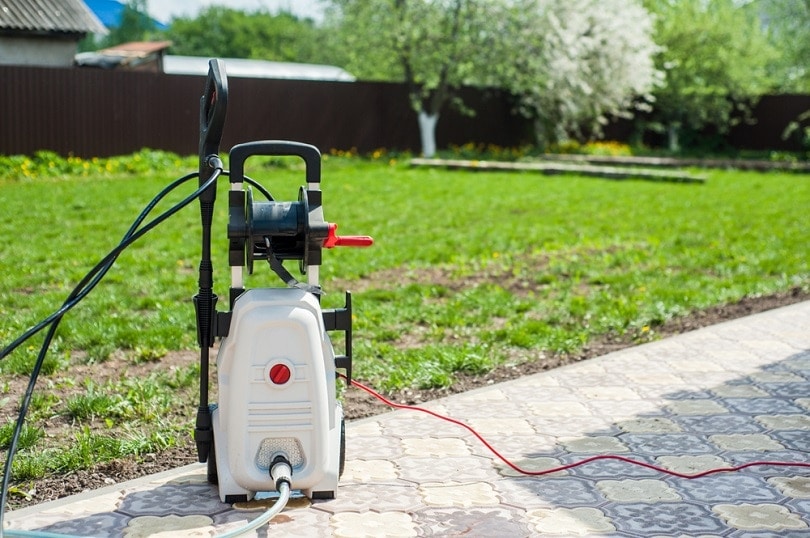
2. Prepare Your Deck
Before you jump in with the pressure hose, prepare your deck for cleaning to help reduce the chances of damage. Prepping your deck beforehand will help reduce the cleaning time with a high-pressure setting and decrease the likelihood of the wood becoming oversaturated and splitting.
Remove any furniture or other items that usually stay on your deck, and use a broom to remove any debris, fallen leaves or twigs, stones, and anything else that the wind may have carried in. Make sure you get into all the corners and crevices. Then, scrub away any mildew or heavily soiled areas by spot cleaning with a stiff brush and some detergent.
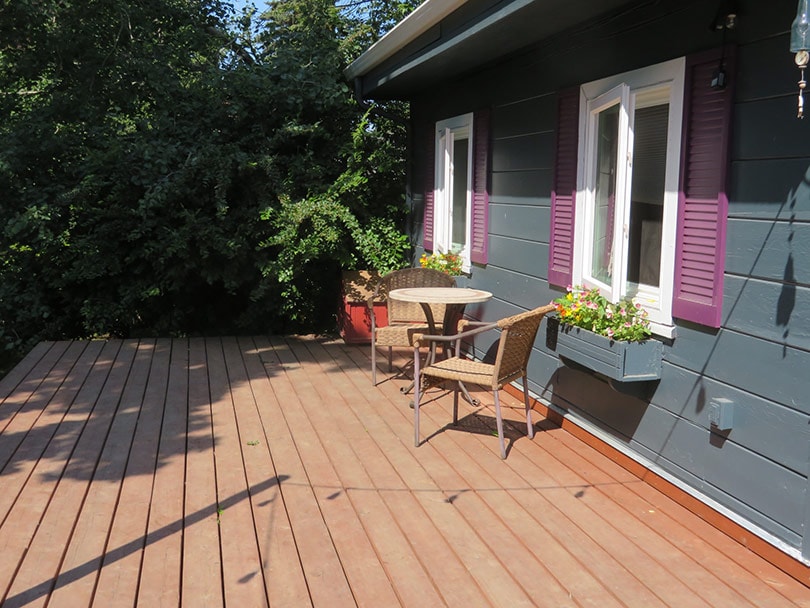
3. Set up your Pressure Washer
To avoid applying too much pressure, use a pressure washer with a maximum pressure output of 150 bar. Fill your washer with an appropriate detergent according to the manufacturer’s instructions. Select the most suitable nozzle, usually a rotary or fan nozzle attachment. These nozzles will provide a circulating or wide spray pattern.
Determine the pressure setting for your deck by analyzing how dirty it is. Depending on how dirty your wood deck is, set your pressure washer setting by using the lowest possible pressure that is still effective. If you pressure wash your deck yearly, and it is lightly stained, a medium setting will do the job. Softwoods such as cedar or pine should be pressured at 500–600 PSI, and harder woods can withstand more pressure but try not to exceed 1,200 PSI.
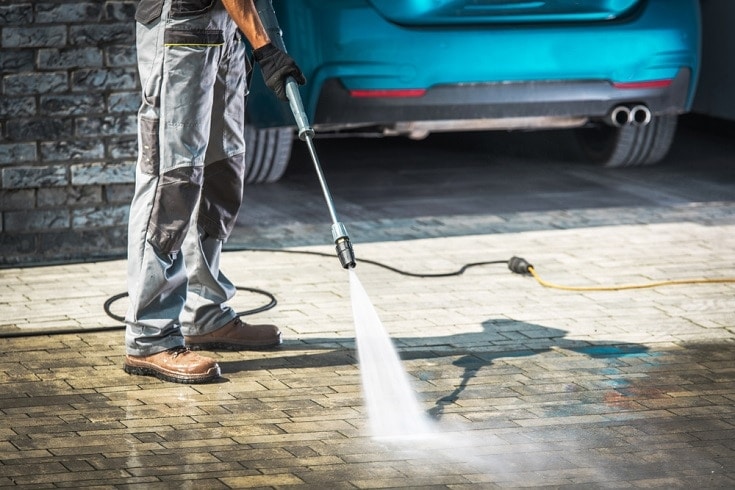
4. Test the Water Pressure Settings
It can take some practice to use a pressure washer. Begin by washing a small area of your decking, such as the boards in the corner. This will allow you to fine-tune the settings and achieve the best spraying range. Since a stair tread is easier to replace than a surface deck board, you may want to practice on the stairs.
Start with a PSI of 500–600 and gradually increase it until you find the ideal setting.
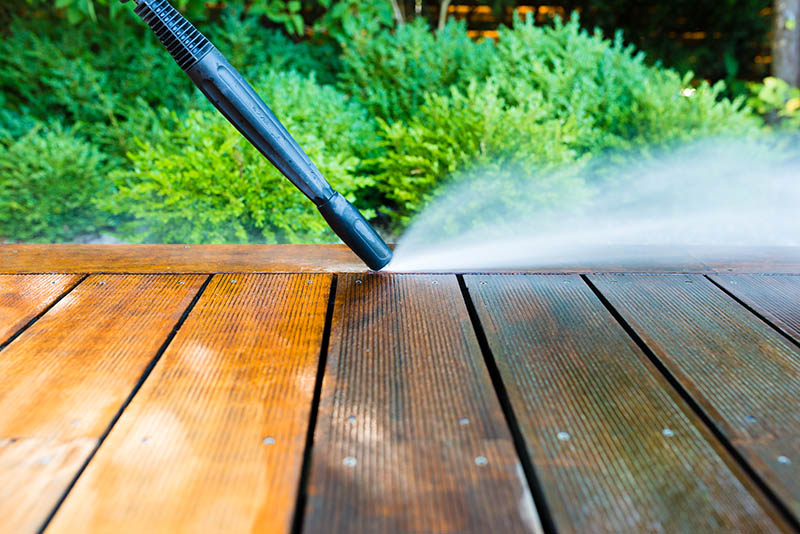
5. Pressure Wash your Deck
Once you’ve completed all of the necessary preparation and pre-cleaning, and you’re ready to power wash your deck, follow these steps and tips for the best results.
- To avoid the risk of damage, hold the tip of the wand 6 inches away from the surface of the deck and engage the trigger.
- Direct your arms in a lateral sweeping motion for even coverage. By moving your arms back and forth, you can try to maintain a consistent distance.
- Start from the house and move outwards, working with the grain of the wood.
- Direct the spray lengthwise and slightly overlap each area to avoid making watermarks.
- Stopping in one spot while spraying can damage the grain and saturate the deck with too much water, so stay consistent.
- To avoid leaving visible cleaning marks, do not change the power settings during the cleaning process.
- Continue to move along the grain of the wood at a steady, smooth, and consistent speed to create an even wash.
- Follow with a rinse using a soft spray setting to erase any leftover soap or debris.
- Cool the wood with water from your garden hose and use a brush to remove any puddles of water.
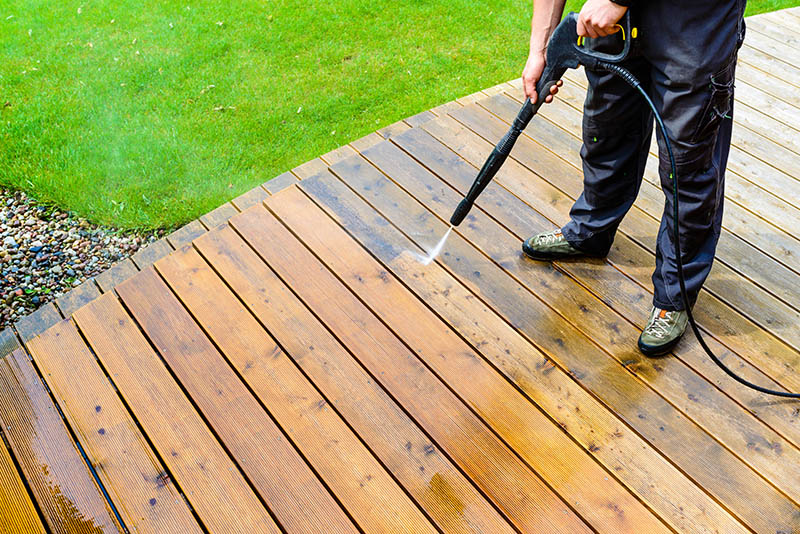
6. Sand Rough Areas
Holding the tip of the pressure washer too close to the wood or leaving it in place for too long can cause rough spots on your deck and erode softwood fibers. This is especially noticeable on handrails, where the raised fibers can cause splinters. If the pressure washer has caused rough spots, you can sand them down, which will also prep your deck for a water sealer. It is not a long task, and your deck will look close to new again. Apply the sandpaper gently and move with the grain of the wood. Then, wipe away any sawdust with a damp cloth.
7. Seal Your Deck (Optional)
If you want to re-seal your whole deck, you will need to sand down the surface to remove any splintering or rough spots. Sanding also opens up the pores of the wood, allowing it to absorb the sealer or stain more consistently.
Before sanding, make sure the wood is completely dry. Follow the manufacturer’s instructions to ensure the sealer will work optimally. If an area does not appear to absorb the sealer, use a small amount of sandpaper to open the pores of the wood, wipe the area clean, and reapply the sealer.
Allow the sealer to dry for a few hours, and avoid walking over it.

What Is the Best Pressure Washer for a Deck?
There are two types of machines that are suitable for pressure washing your deck: gas and electric. Making the decision between electric and gas pressure washers is critical because it can make or break your cleaning process. Electric pressure cleaners are ideal for cleaning small decks because they typically provide a PSI of 1,000–2,000.
They are generally more compact and lightweight, don’t emit too much noise, and don’t require high maintenance. However, gas-powered washers can remove tough dirt from large decks and are ideal if you want to clean faster and more often.
When choosing a pressure washer to do the right job, one of the most important factors is the PSI and GPM. The higher the PSI and GPM, the more power the machine has to tackle tough jobs and stains. The ideal PSI for pressure washing a deck is 500–600 PSI for softwood and 1,200–1,500 for hardwood.
In Conclusion
Pressure washing your deck can transform the overall look of your home and clear away dirt and grime that has accumulated for years. It is also a great way to prepare a deck that needs to be resealed. The power of a pressure washer can also cause some damage, especially if you are unfamiliar with the machine and how it works, so make sure you get comfortable with it beforehand, so there are no unwanted surprises. We hope these tips have provided enough insight on how to pressure wash your deck from beginning to end and to keep it looking great.
See Also:
- How to Clean a Wood Deck Without a Pressure Washer (7 Easy Tips)
- 10 Tips on How to Pressure Wash a Rug
Featured Image Credit: bubutu, Shutterstock
Contents



